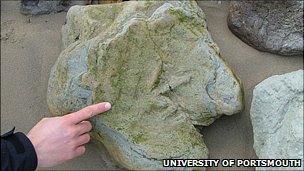Isle of Wight rock yields three fossil footprints
- Published

The rock contains the fossilised footprints of three different dinosaurs
A boulder with three different fossilised dinosaur footprints has been found on an Isle of Wight beach.
It provides evidence about life around Brook Bay 130 million years ago.
Palaeontologist Dr Steve Sweetman found the 50kg (110lb) rock containing prints of an adult iguanodon, a theropod and a baby iguanodon-like dinosaur.
He said: "It is a remarkable fossil providing tantalising evidence of the existence of animals for which we have the merest scraps of bones."
Ideal conditions
The Isle of Wight is internationally renowned for fossils because its habitat provided ideal conditions for dinosaurs to roam.
Dr Sweetman, a vertebrate palaeontologist at the University of Portsmouth, explained the rock showed that a large iguanodon plant-eating dinosaur was wandering about in a muddy riverbank leaving deep footprints 45cm wide and 50cm long (17in by 20in).
Dr Sweetman said: "There are hundreds of footprints on the beach at Brook Bay but it's extraordinary to find three in one, and the little theropod print is unique.
"It was a truly busy place teeming with life and, in the shadow of the large dinosaurs, tiny ones of all shapes and sizes were also thriving," he added.
Dr Sweetman sought permission from the beach owners, the National Trust, to remove the specimen before it was washed away.
The find will be donated to the island's Dinosaur Isle Museum.
- Published16 June 2010